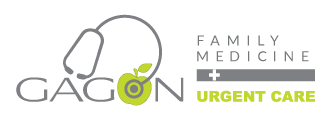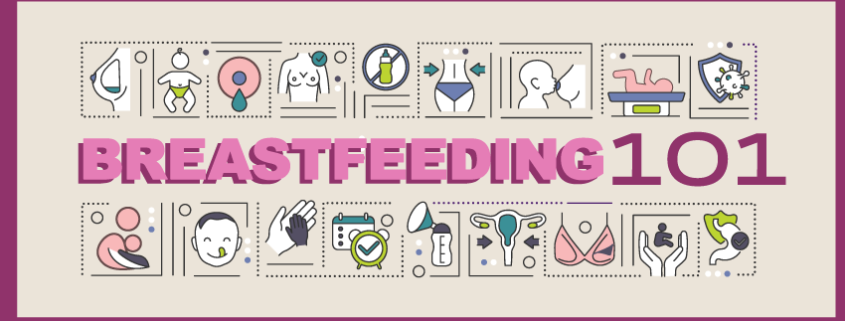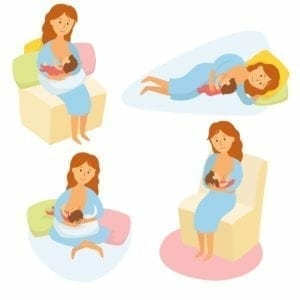Breastfeeding 101: Hints to Help You Get Off to a Good Start
from: familydoctor.org/breastfeeding-hints-to-help-you-get-off-to-a-good-start
Breastfeeding has many benefits for your baby. Breast milk is rich in nutrients. It has antibodies, which help protect your baby against infections. It also can help prevent sudden infant death syndrome (SIDS). Babies who are breastfed are less likely to have allergies, asthma, and diabetes. They also are less likely to become overweight.
Breastfeeding has benefits for you as well. It’s cheaper than using formula. You don’t have to wash bottles or mix formula. It helps your uterus go back to normal size after stretching out during pregnancy. This can help you lose weight faster. It can delay the return of your periods. However, you shouldn’t count on it to prevent pregnancy. Breastfeeding helps make time for you to be close to your baby. Women who breastfeed have lower risks of type 2 diabetes, breast cancer, ovarian cancer, high blood pressure, and heart disease.
Path to improved health
Breastfeeding promotes wellbeing for you and your baby. Although it is a natural part of the birthing process, it’s not always easy. Many women need help learning how to breastfeed. The American Academy of Family Physicians (AAFP) recommends that all doctors provide assistance to women during pregnancy and after birth to support breastfeeding. Your doctor may recommend breastfeeding for at least the first 6 months of your baby’s life.
Below are helpful tips to help you get off to a good start.
Before you give birth
During pregnancy, the following things can prepare you for breastfeeding.
- Prenatal care. It’s important to take good care of yourself and your baby. Babies who are born early (premature) have a harder time breastfeeding.
- Talk to your doctor. Make sure your doctor knows you plan to breastfeed. They can give you some resources. Ask questions about what type of care the hospital provides after birth. Some offer lactation consultants, who are breastfeeding specialists.
- Breastfeeding class. Some women find that taking a class can help them practice for the real thing.
- Breastfeeding items. Plan ahead by purchasing the items you need. These can include a nursing pillow, nursing bra, and covers. Some hospitals and insurance plans provide free breast pumps.
Breastfeeding 101
Once your baby is born, your breasts will start to fill up. At first, your body will produce a “pre- milk,” called colostrum. This can be thin and watery or thick and more yellow-colored. The pre-milk has a slower flow to help your baby learn to nurse. After 3 to 4 days of nursing, your real breast milk will come in.
Most babies are ready to eat 1 to 2 hours after birth. Below is a step-by-step guide on how to breastfeed.
- Wash your hands before each feeding.
- Place your baby in one of the breastfeeding positions (outline below).
- Put the thumb of your free hand on top of your breast and your other fingers below.
- Touch your baby’s lips to your nipple until your baby opens their mouth wide.
- Put your nipple all the way in your baby’s mouth and pull your baby close to you. This lets your baby’s jaw squeeze the milk ducts under your areola (nipple).
How do I know if my baby is latched on?
When your baby is “latched on,” the right way, both lips should pout out and cover nearly all of your areola. Your baby’s jaw should begin to move back and forth. Your baby may make low- pitched swallowing noises instead of smacking noises. If you feel pain while your baby is nursing, they may not be latched on.
Your baby’s nose may touch your breast during nursing. Babies’ noses are designed to allow air to get in and out. If you’re concerned your baby can’t breathe easily, gently press down on your breast near your baby’s nose to give them more room to breathe. Your baby shouldn’t have to turn his or her head or strain his or her neck to nurse.
How should I hold my baby while breastfeeding?
You can hold your baby in a number of ways. Some of the most common positions are:
- Cradle. Put your baby’s head in the crook of your arm. Support your baby’s back and bottom with your forearm. Your baby should be lying facing you. Your breast should be right in front of your baby’s face.
- Side-lying.While lying down, place your baby alongside you. Your baby should be facing you. Pull your baby close to you so he or she can latch on. You can use a pillow to prop up, if needed. This position can help if you had a cesarean section (C-section). You don’t want to fall asleep while nursing in this (or any other) position. Co-sleeping can be dangerous for your baby. It increases the risk of Sudden Infant Death Syndrome (SIDS).
- Football. Tuck your baby under your arm, along your side. His or her head should be resting in your hand. Support your baby’s body with your forearm. Your baby should be facing you. This position can help if you had a C-section. It also can help if your breasts are large, your baby is small, or you have multiple babies.
- Cross-cradle. Hold your baby with the opposite arm of the breast you’re using. Support your baby’s head and bottom with the palm of your hand and forearm. Your baby should still be lying facing you. This position can help premature babies or babies who have a weak suck. It provides added head support.
What is the let-down reflex?
The let-down reflex means your milk is ready to flow. It makes breastfeeding easier for you and your baby. You may feel a tingle in your breast(s) as you start to breastfeed. Milk may drip from the breast not being used. These are signs that your milk has “let-down.” The let-down reflex also may occur if a feeding is overdue, if you hear a baby cry, or if you think about your baby.
The reflex can be forceful enough to cause your baby to cough. If this is a problem, try to discharge some of your milk by hand before a feeding.
How often should I feed my baby?
Feed your baby as often as he or she wants to be fed. Learn how to tell when your baby is hungry. Crying can be a sign of hunger, but it may be too late. Babies who are crying or are upset have a harder time latching on. Watch out for early signs of hunger. Your baby may:
Make sucking motions.
Turn toward the breast if they are being held. Put their hands in their mouth.
Become excited or alert.
After birth, your baby may be hungry 8 to 12 times a day or more. This number may decrease over time or increase during a growth spurt. Growth spurts occur at about 2 weeks and 6 weeks of age and again at about 3 months and 6 months of age.
Let your baby eat until they are satisfied. This may be for about 15 to 20 minutes at each breast. Try to have your baby nurse from both breasts at each feeding. Make sure your baby finishes one breast before starting the other. Your baby should let go on their own once they are done.
Don’t limit the time you let your baby nurse. It may keep your milk ducts from completely emptying. This can decrease your milk flow and make it harder for your baby to latch it on. It also can cause swelling and pain. Applying a cold compress before nursing can ease discomfort.
How do I know if my baby is getting enough milk?
Your baby is getting enough milk if he or she:
Acts satisfied after each feeding.
Gains weight consistently after the first 3 to 7 days after birth. (Your baby may lose a little weight during the first week after being born.)
Has about 6 to 8 wet diapers a day.
Has about 2 to 5 or more stools a day at first. This number may decrease to about 2 stools or less a day.
Sometimes babies fall asleep while nursing. You can squeeze your breast to make more milk flow. This may awaken your baby. If you are not sure he or she got enough milk, offer your other breast to see if your baby latches on again.
How can I increase my milk supply?
If you think your baby needs more milk, increase the number of feedings a day. It’s important for you to get plenty of rest and eat right. Give your body time to catch up to your baby’s demands.
Don’t replace breast milk with baby formula or cereal. This can make babies lose interest in breast milk. It also will decrease your milk supply. You shouldn’t give your baby solid foods until about 6 months of age.
What if I work?
There is no reason you have to stop breastfeeding when you return to work. Make a plan for pumping your breast milk at work. The federal Break Time for Nursing Mothers law requires your employer to provide basic accommodations for breastfeeding mothers at work, according to the U.S. Department of Health and Human Services (HHS). “These accommodations include time for women to express milk and a private space that is not a bathroom each time they need to pump,” reports the HHS.
Breastfeed your baby before you leave for work, and every 3-4 hours at work (or however often you would normally feed your baby). Keep the milk refrigerated and your baby can have it the next day while you are at work. It keeps for up to 4 days in the refrigerator. If you aren’t going to use the milk within 4 days, freeze it. Breastmilk will last up to 6-12 month in the freezer. After work, breastfeed your baby as you normally would.
Things to consider
What food should I eat while breastfeeding?
The best diet is well balanced and has plenty of calcium. A balanced diet includes eating from all 5 food groups. You should get 5 servings of milk or dairy products each day. It is okay to eat foods that were restricted while you were pregnant. These will not make your baby sick.
If you don’t eat meat or dairy, you can get calcium from foods such as broccoli, sesame seeds, tofu, and kale. Talk to your doctor about taking a calcium supplement if you don’t get enough from your diet.
You should eat about 500 extra calories per day. Make sure you drink extra fluids as well. Continue to take a prenatal vitamin so your body gets enough nutrients.
What should I avoid while breastfeeding?
Certain foods can bother your baby. They may make him or her fussy or gassy. Pay attention to what you eat and how your baby acts after feedings. Stop eating foods that affect them.
These may include spicy foods, broccoli, or milk.
Some babies react to cow’s milk in your diet. Symptoms can include gas, vomiting, diarrhea, rash, or colic. Your baby also can have an allergic reaction to something you eat. Common foods are eggs and peanuts. They may get a rash or have trouble breathing. Contact your doctor right away if your baby has any of these signs.
Limit your intake of caffeine and alcohol. These can get into your milk. Don’t have more than a couple cups of coffee, tea, soda, or other caffeine each day. Don’t have more than one alcoholic drink each day. Avoid drinking caffeine and alcohol less than 2 hours before a feeding.
Some medicines can get into your milk. This includes over-the-counter drugs and prescriptions, such as antidepressants and birth control medicines. Don’t take anything without talking to your doctor first. Smoking also is bad for breastfeeding. The chemicals and smoke can get in your milk. Smoking can cause you to make less milk. If you smoke, try to quit.
If possible, avoid using bottles or pacifiers after birth. This can confuse your baby and make breastfeeding harder.
What can I do if my nipples get sore?
It’s easier to prevent sore nipples than it is to treat them. The main cause of sore nipples is when your baby doesn’t latch on the right way. You need to start over to correct this. To take your baby off your breast, release the suction by putting your finger in the corner of your baby’s mouth between the gums. Switch breasts and try to breastfeed again.
Other ways to help prevent and heal sore nipples are:
Make sure your baby is sucking the right way. If the sucking hurts, your baby’s mouth may not be in the right position.
Offer your baby the less sore of your two nipples first. Your baby’s sucking may be less forceful after the first few minutes.
If possible, position cracked or tender parts of your breast at the corner of your baby’s mouth. This way the spots get less pressure during feeding.
Change positions.
Let your nipples air dry between feedings. Let the milk dry on your nipples instead of wiping it off.
Wash your nipples daily with warm water. Don’t use soap or lotion that may contain alcohol. This can dry out your skin.
Rub lanolin on your nipples to help soothe them.
Avoid bra pads lined with plastic. Change bra pads between feedings to keep your nipples dry.
Discharge milk with your hand until the let-down reflex occurs. This can help make your milk flow easier so your baby sucks less hard.
When to see your doctor
Call your doctor if you have:
A red, sore, or painful spot on your breast. Painful engorgement (overfull breasts).
A fever or if you feel achy. These may be signs of an infection.
You also should call your doctor if your baby is losing weight for no apparent reason.
Questions to ask your doctor
Where can I take a breastfeeding class?
What type of breastfeeding care and information will the hospital provide after birth? What should I do if my baby won’t latch on?
What can I do if my body is not producing enough milk? Is it okay to give my baby bottles or pacifiers?
Resources
National Institutes of Health, MedlinePlus: Breastfeeding
U.S. Department of Health & Human Services, Office on Women’s Health: Learning to Breastfeed




